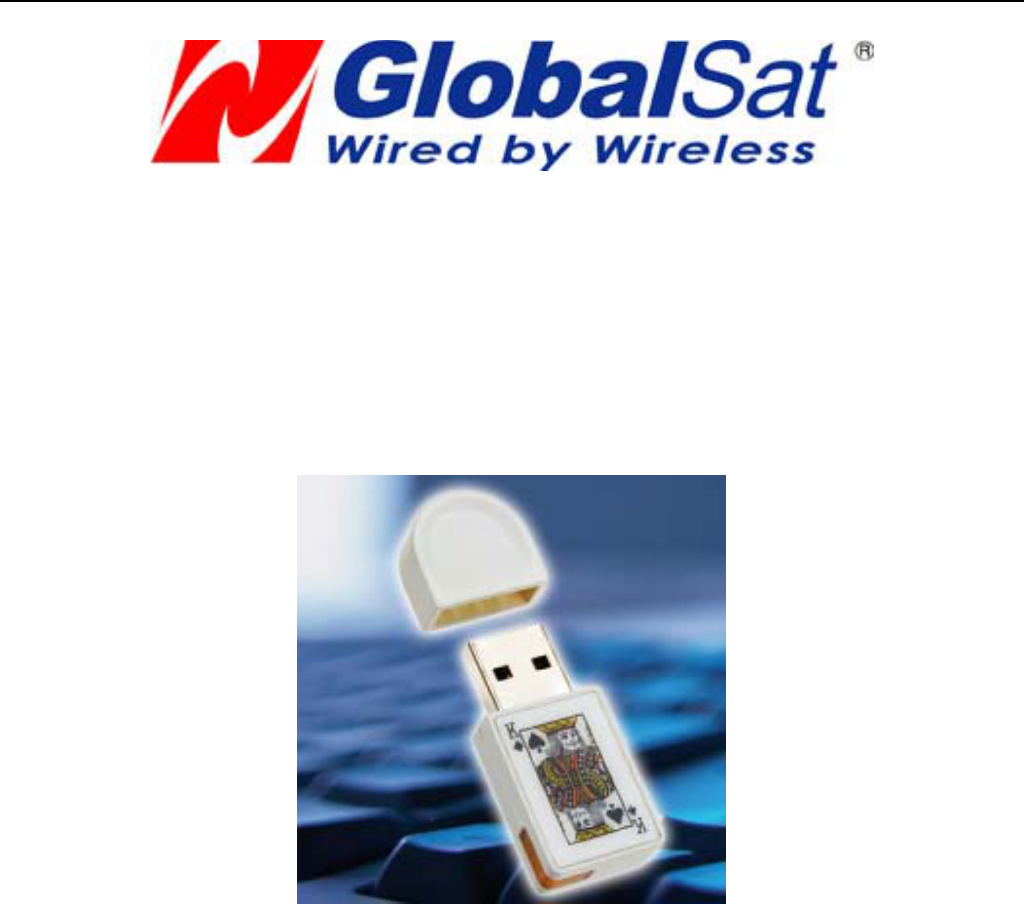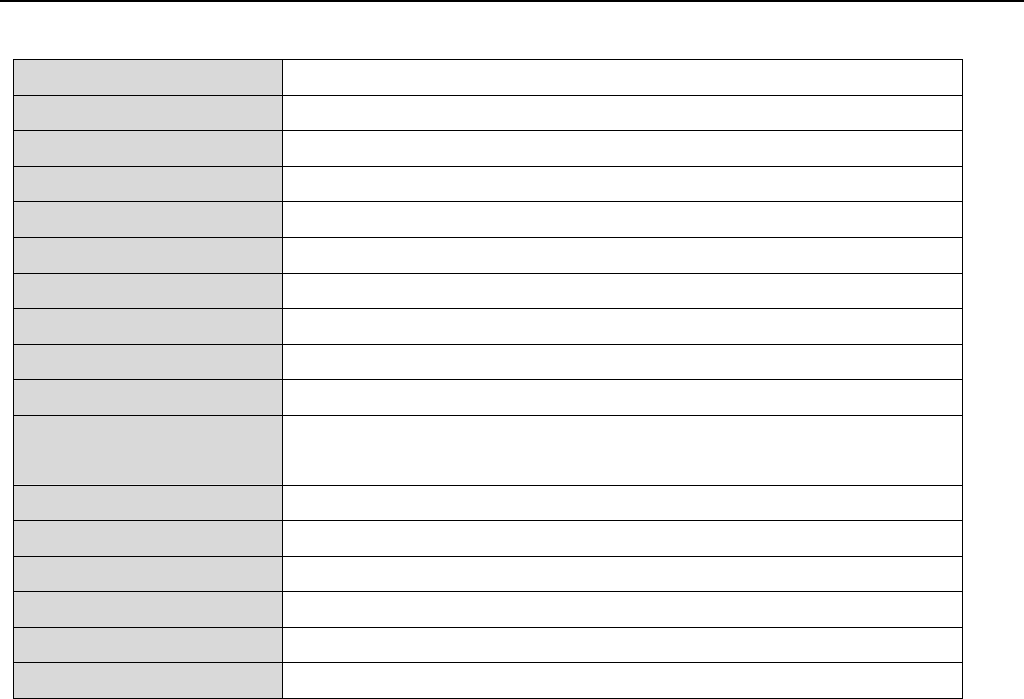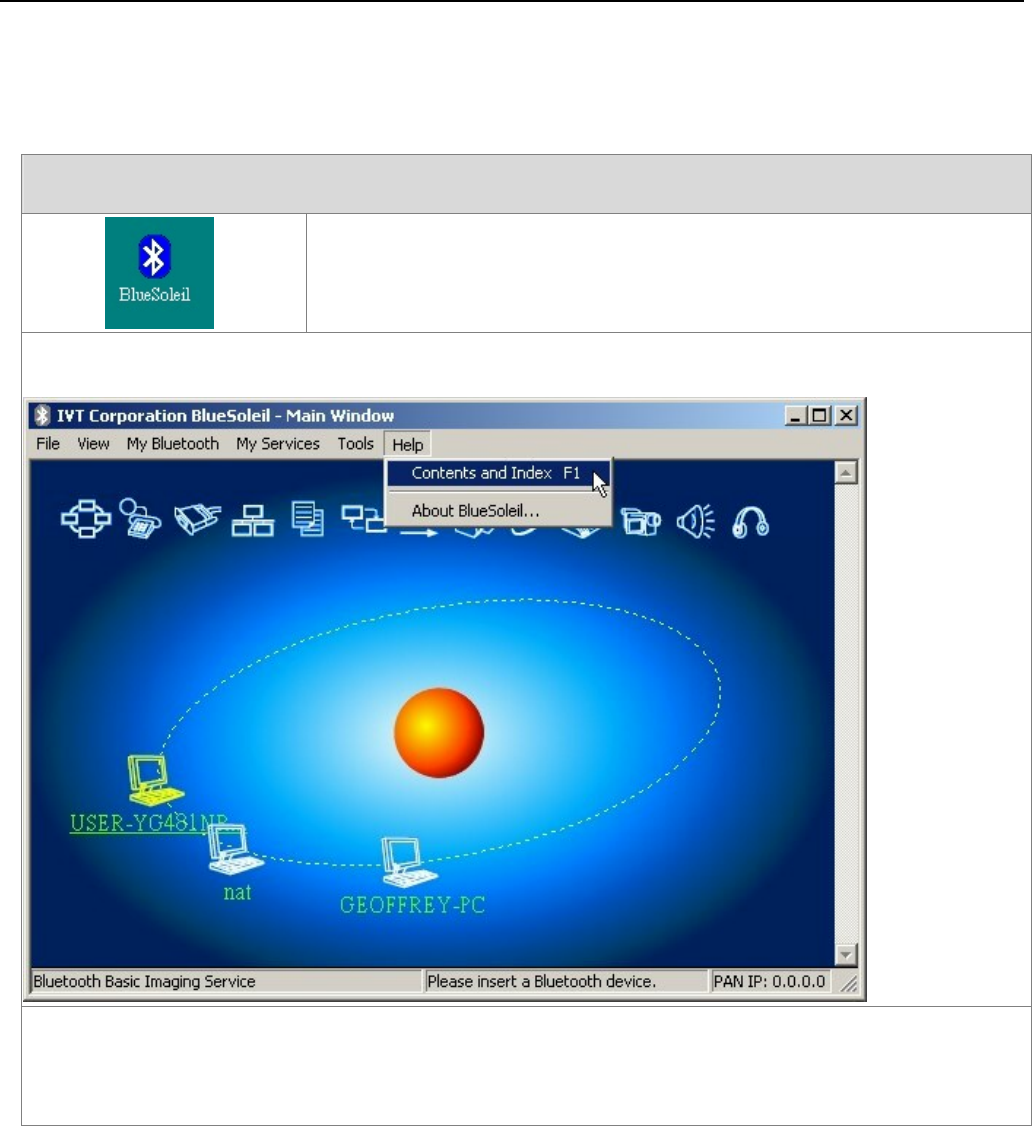GlobalSat WorldCom BTA-806 Bluetooth USB Dongle User Manual Manual
GlobalSat WorldCom Corporation Bluetooth USB Dongle Manual
Manual

BTA-806 User Manual page 1 of 8
BTA-806
Bluetooth Dongle
User manual, version 0.75
Copyright
© 2005 GlobalSat Technology Corporation. All rights reserved
The trademarks mentioned in this document are legally registered to their respective companies.

BTA-806 User Manual page 2 of 8
1. Introduction
Our latest Bluetooth Dongle has been designed and developed specifically for all current Bluetooth
devices. The USB Bluetooth 2.0 Dongle combines the latest features with premium levels of quality
and reliability. It enables networking products through Bluetooth capable of data transfer among
devices such as PDAs, printers, mobiles, computers, and other emerging electronic devices.
Compatible with USB 1.1 and 2.0, the BTA-806 supports Windows XP/2000/Me and installs quickly
and easily to a desktop or notebook computer with an available USB port.
1.1. Package
Before you start up, make sure that your package includes the following items. If any items are
missing or damaged, contact your dealer immediately.
y BTA-806 Bluetooth dongle
y CD (including the driver)
1.2. Features
y Bluetooth v2.0 EDR compliant (Class II)
y Frequency Hopping Spread Spectrum (FHSS) for better connections
y High Speed data transfer up to 3Mbps
y Connects up to 7 BT devices to the PC
y Implements a Personal Area Network (PAN)
y Uses 2.4GHz ~ 2.4835GHz ISM band
y Connection range up to 10 Meters (32 feet)
y Activity indicator LED
y Plug and Play
y LMP improvements

BTA-806 User Manual page 3 of 8
2. Specification
Model Name BTA-806
Product Description Bluetooth USB dongle
USB Interface 1.1
Certification FCC, CE
Bluetooth Version Bluetooth v2.0 EDR
RF Output Power Class 2
Frequency 2.4GHz ~ 2.4835GHz ISM band
Spread Spectrum FHSS (Frequency Hopping Spread Spectrum)
Operating Range 10 meters (32 feet)
Sensitivity -80dBm @0.1%BER
Bluetooth Profile SYNC、SPP、HCRP、PAN、OPP、LAP、HID、FTP、FAX、
A2DP、AVRCP、DUN、BIP
LED 1 LED
Operation Temperature -10 ºC ~ 55 ºC
Storage Temperature -20 ºC ~ 60 ºC
Humidity 10% ~ 90% non-condensing
Dimensions 42 * 18 * 8mm (L * W * T)
Power Consumption Working: 58mA , Stand by: 13mA
3. Installation
Install the driver before you use the Bluetooth dongle.
1) Please place the driver CD into CD-ROM drive, the Autorun program will start automatically.
Please select the language you want. If the Autorun program does not start, please manually
run it by double click on the “setup.exe” from CD root directory.
2) The Autorun program will prepare to install the driver for you, please follow the instruction to
complete the installation process.
3) After the installation is completed, please restart your system to take effect of the driver.

BTA-806 User Manual page 4 of 8
4. Start the connection software
Start the IVT BlueSoleil software
1. Please double click on the “BlueSoleil” icon from desktop to start
the BlueSoleil software, or click from Start Æ Programs Æ IVT
BlueSoleil Æ BlueSoleil.
2. Click on the red ball to start or stop searching for Bluetooth devices in range.
3. For more information about the BlueSoleil, please see its Online Help. You can start the
Online Help by clicking Help Æ Contents and Index from main menu or press the F1 key.

BTA-806 User Manual page 5 of 8
5. Connecting device
Find Remote Devices
To set up a Bluetooth connection, the remote device must be found first. There are 3 ways to find
remote devices in BlueSoleil.
Inquire Device
1. Single-click the red ball in the main window to start inquiry.
2. Bluetooth devices within the radio range will be shown around the center ball.
3. Wait for a few seconds until the names of all the devices are obtained.
Connect and Disconnect
Connect
1. Select a remote device and double click it to browse its services.
Bluetooth passkey may be asked if security level of either side is set to high and they are not
paired devices.
After service browsing, the services the remote device supports are highlighted by changing
the color of the service buttons on the top of the main window.
2. Single click one of the service button to connect.
After connection is setup, the remote device and the service button will turn green.
Note: Users can right click the remote device icon or the service button to pop up operation menu
for connection.
Disconnect
Method 1: Select the remote device, right click the service button. On the popup menu, select
Disconnect.
Method 2: Right click the device icon. On the pop-up menu, select Disconnect | (the connection
you want to disconnect).
Method 3: For FTP and Synchronization connection, close the operation window, the connection
will be disconnected.
Method 4: Disconnect from the remote device directly.
Method 5: If the local Bluetooth device is removed or the remote device is powered off, all the
connections will be disconnected. If the remote device moves out of the radio range, all
the connections with the remote device will be disconnected in 1 minute.
Pair / Un-pair Devices
Once a remote device has paired with your computer by exchanging passkeys, passkeys will no
longer be required for further connections between your computer and the device.
How to pair with another device
• Automatically
If a passkey is required for connection, the devices will be paired automatically the first time
they successfully exchange passkeys and connect. After a device has successfully paired

BTA-806 User Manual page 6 of 8
with your computer, the remote device icon in the Main Window will have a red checkmark
next to it.
• Manually
In the Main Window, right click on the device icon, and in the pop-up menu, select Pair
Device. In the Enter Bluetooth Passkey dialog, enter the same passkey that you enter on
the remote device. After a device has successfully paired with your computer, the remote
device icon will have a red checkmark next to it.
How to un-pair with another device
• Manually
In the Main Window, right-click on the device icon, and in the pop-up menu, select Unpair.
The red checkmark next to the device icon will disappear.
AV Headphone
The AV Headphone Profile enables users to use a Bluetooth enabled headphone to listen
high-quality stereo music played in a computer.
Typical Usage
• Listen to music using a Bluetooth enabled AV Headphone.
Steps:
1. Connect to AV Headphone.
2. Double click on the headphone icon to enable the connection, and then play music using
media player software on your computer. Music will be transmit wirelessly to the headphone.
File Transfer
The File Transfer Profile (FTP) enables users to transfer files and/or folders between Bluetooth
enabled laptops, desktops, PDAs, mobile phones, etc.
Typical Usage
• Connect to a Bluetooth enabled mobile phone and transfer files or folders to/from the phone.
• Share a folder on your computer with other Bluetooth enabled devices.
• Access a shared folder on another Bluetooth enabled device.
Connect to a Phone
Steps:
1. Connect to the phone's FTP service.
2. The phone's folders are shown in a window. Users can copy/paste/delete files or folders.
Share a Folder on Your Computer with other Bluetooth Enabled Devices
Steps:
1. Select the folder you would like to use for file sharing and define the remote user privileges.
Click My Services | Properties. Click on the File Transfer tab.

BTA-806 User Manual page 7 of 8
Share this folder: Browse to select the folder your would like to share.
Share Permissions: Select Read and Write to allow others to copy, paste or delete
files/folders in this folder. Select Read Only to allow others to only browse and copy
files/folders from this folder.
2. Start the FTP service in BlueSoleil. Do not initiate the connection in BlueSoleil.
3. Browse your computer from the remote device. For instructions, refer to the user
documentation for the remote device. When the remote device attempts to connect to your
computer, the Bluetooth Service Authorization screen may appear. Click Yes.
4. After successfully connecting, the remote device can browse, copy, paste, and/or delete files
on your computer, depending on the remote folder privileges you allowed. For instructions,
refer to the user documentation for the remote device.
Access a Shared Folder on Another Bluetooth Enabled Device
1. On the remote device, designate the folder/files to share. Enable file sharing on the remote
device. For instructions, refer to the user documentation for the remote device.
Note: If you do not enable file sharing on the remote device, BlueSoleil will not be able to
discover the device’s file sharing service.
2. Start the FTP service and initiate the connection in BlueSoleil.
3. A Remote Shared Folder screen will appear, displaying shared files/folders on the remote
device, Use the screen to browse, copy, paste, and/or delete files, depending on your folder
privileges.
Headset
The Headset Profile enables users to use a Bluetooth headset as wireless earplug or microphone.
Typical Usage
• Use Headset as a device for audio input/output.
Use Headset as Sound Input/Output Device
Steps:
1. Connect to the Bluetooth enabled headset.
2. Play music on your computer or chat using network meeting tools. You may need to press a
multifunction button on your headset to transmit audio between the computer and the
headset.
Note: For most Bluetooth enabled headsets, after you have successfully connected for the first time,
you can quickly reconnect to BlueSoleil by simply pressing a multifunction button on the headset.

BTA-806 User Manual page 8 of 8
Federal Communications Commission (FCC) Statement
15.21
You are cautioned that changes or modifications not expressly approved by the part responsible for
compliance could void the user’s authority to operate the equipment.
15.105(b)
This equipment has been tested and found to comply with the limits for a Class B digital device,
pursuant to part 15 of the FCC rules. These limits are designed to provide reasonable protection
against harmful interference in a residential installation. This equipment generates, uses and can
radiate radio frequency energy and, if not installed and used in accordance with the instructions,
may cause harmful interference to radio communications. However, there is no guarantee that
interference will not occur in a particular installation. If this equipment does cause harmful
interference to radio or television reception, which can be determined by turning the equipment off
and on, the user is encouraged to try to correct the interference by one or more of the following
measures:
-Reorient or relocate the receiving antenna.
-Increase the separation between the equipment and receiver.
-Connect the equipment into an outlet on a circuit different from that to which the receiver is connected.
-Consult the dealer or an experienced radio/TV technician for help.
Operation is subject to the following two conditions:
1) this device may not cause interference and
2) this device must accept any interference, including interference that may cause undesired
operation of the device.
FCC RF Radiation Exposure Statement:
This equipment complies with FCC radiation exposure limits set forth for an uncontrolled
environment. End users must follow the specific operating instructions for satisfying RF exposure
compliance. This transmitter must not be co-located or operating in conjunction with any other
antenna or transmitter.